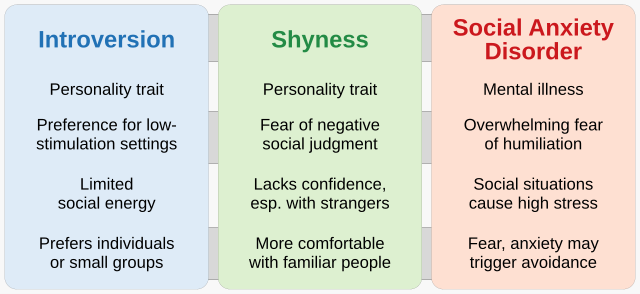Extraversion and introversion
personality trait From Wikipedia, the free encyclopedia
Remove ads
Introversion and extraversion (also spelled extroversion[1]) are ways of describing a person's personality.[2] People who are more extraverted are called extraverts (or extroverts). People who are more introverted are called introverts.

History
This idea was proposed by psychiatrist Carl Jung in the 1920s.[3]
Ideas
He said that introversion and extraversion affects how people behave socially (with other people), and also where they get mental energy from. Introverts prefer being alone and extraverts prefer being with other people. Introverts get energy and pleasure from self-reflection, and may feel tired after being around other people.[4] Extraverts are the opposite. They get energy from spending time with other people, and may feel bored and tired after being alone.[5]

Spectrum
Introversion and extraversion exists on a spectrum.[2] Everyone has a different amount of introverted and extraverted personality traits. People with more extraverted traits are called extraverts (or extroverts), and people with more introverted traits are called introverts. People who are around the middle of the spectrum may be called ambiverts.[6]
Remove ads
Introversion vs. shyness and social anxiety

Some people mistake introversion for shyness or social anxiety because they can appear similar, but they are separate things. Introversion is a personality trait, but shyness and social anxiety are caused by distress. Introverts usually prefer being alone, but are not scared of being around other people.[7][8]
Related pages
References
Wikiwand - on
Seamless Wikipedia browsing. On steroids.
Remove ads
